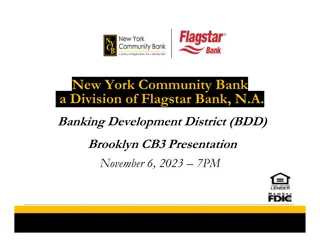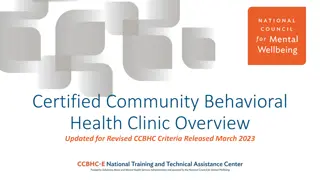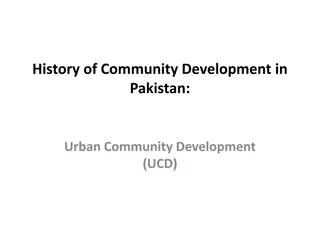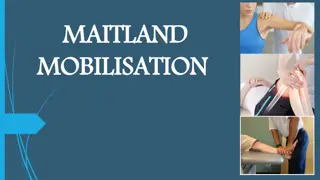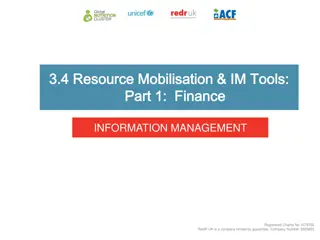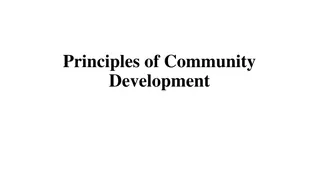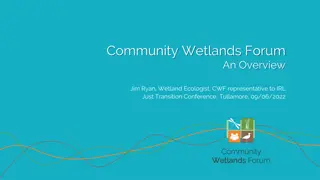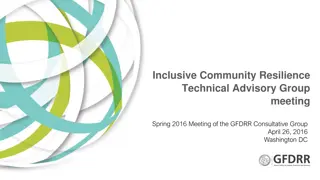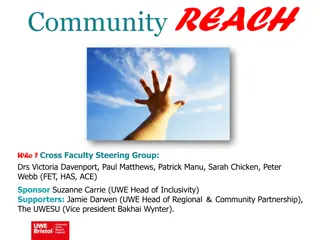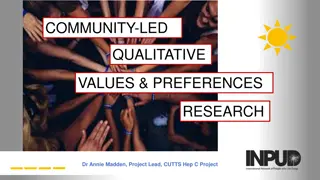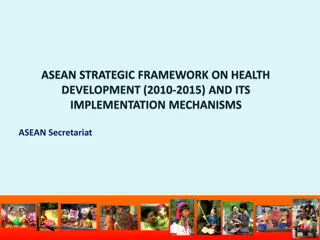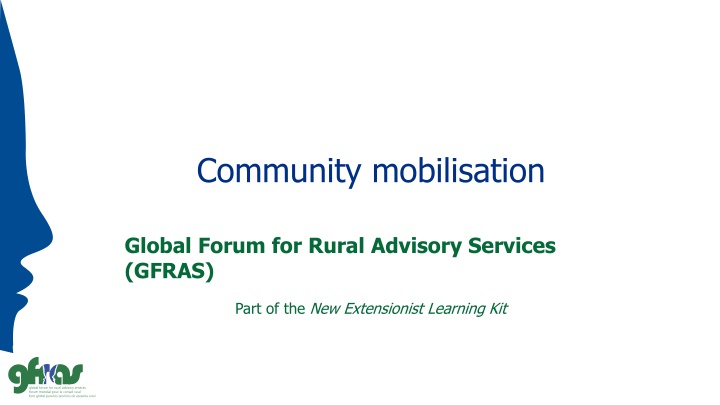
Community mobilisation
Community mobilisation involves empowering local groups to identify and address their needs collectively, emphasizing community involvement and recognizing the importance of diversity and inclusion. Study unit 1 focuses on understanding culture, diversity, gender, and youth within local communities, highlighting the significance of inclusive decision-making processes and historical influences of cultural groups.
Download Presentation

Please find below an Image/Link to download the presentation.
The content on the website is provided AS IS for your information and personal use only. It may not be sold, licensed, or shared on other websites without obtaining consent from the author. If you encounter any issues during the download, it is possible that the publisher has removed the file from their server.
You are allowed to download the files provided on this website for personal or commercial use, subject to the condition that they are used lawfully. All files are the property of their respective owners.
The content on the website is provided AS IS for your information and personal use only. It may not be sold, licensed, or shared on other websites without obtaining consent from the author.
E N D
Presentation Transcript
Community mobilisation Global Forum for Rural Advisory Services (GFRAS) Part of the New Extensionist Learning Kit
What is community mobilisation? A process where local groups are helped to clarify and express their needs and objectives It emphasises the involvement of the people themselves in determining and meeting their own needs It recognises that the problems the local population may face cannot always be solved on an individual basis
Study unit 1 Culture and diversity including gender and youth
Overview Study unit 1 is about: The relevance of culture and diversity in guiding a local community to develop a vision The components involved in building a diverse and inclusive community that recognises women and youth
Understanding culture and diversity Culture is a strong part of people s lives. To understand culture and diversity, you will need to know: How to overcome and prevent divisions The importance of inclusion in decision making processes How cultural groups influenced history
Difference Between Culture and Diversity This short video explains the difference between culture and diversity
Vision for inclusive local community You need to be aware of diversity in a community so that you understand: Relationships between cultural groups; Building alliances and coalitions within cultural groups; Common issues that different cultural groups have.
Building diverse and inclusive community Dignity and hope are important in community mobilisation and you will need to keep vulnerable groups in mind Your community mobilisation team has to be diverse as well In order to make community mobilisation effective, you need to use the diversity in the community
Enhancing women and youth participation and productivity Gender roles are largely determined by culture Due to cultural norms, youth may be excluded from participatory activities Targeting and providing safety-net support for women and youth will enable them to contribute more to the community
Closing the gap between men and women in agriculture The world cannot eliminate hunger without closing the gap between men and women in agriculture. With equal access to productive resources and services, such as land, water and credit, women farmers can produce 20 to 30 percent more food, enough to lift 150 million people out of hunger.
Study unit 2 Livelihood assets assessment
Overview Study unit 2 is about: The sampling and assessment planning process; and The core components of livelihood assets assessment and analysing the results.
Gathering information You must: Set objectives Choose the correct assessment type Use the correct data collection methods
Information needed for a livelihoods assets assessment When doing livelihood assets assessment you must consider if the following are available: Natural capital Human capital Social capital Physical capital Financial capital
Sampling and assessment planning Involves context analysis, stakeholder mapping, engagement and livelihoods zoning, gathering information and meeting with key stakeholders in the community
Sampling and assessment planning Formulate objectives, select sampling method, recruit the team, develop tools for the tasks, set up time allocation for the tasks
Sampling and assessment planning Do surveys, identify coping strategies, do vulnerability and capacity mapping and hazard mapping
Sampling and assessment planning Order the data and enter into a database
Sampling and assessment planning Share report with communities
Core components of livelihood assets assessments Context analysis will help you understand the factors that influence livelihood systems Food security determined by food availability and how easily and regularly people have access to food Coping strategies are the actions that people take at a household level to manage their resources in times of hardship
Analysing results Data analysis is an ongoing process The results will identify the principal causes of food insecurity and risks to livelihoods You can use the data to establish a vulnerability ranking
Study unit 3 Problem solving approaches
Overview Study unit 3 is about: Describing community decision making based on data Explaining the root causes of problems Devising sustainable community solutions in a participatory manner
Defining problems and their root causes You need to know exactly what needs to be changed to fix a problem If you address the root cause of a problem, you are more likely to solve it
Participatory development of a basket of options You will need to have the option of a range of solutions for a problem to eliminate possibilities that do not address the causes: Generate potential solutions Relate solutions to root causes Merge similar solutions
Participatory selection of an appropriate solution Look at two general criteria: How feasible the solution is How acceptable the solution is to the community
Participatory implementation Participatory implementation is important You have to get the community involved in making changes There are several steps involved
Participatory implementation What must be done? Why are these actions a solution? Who will do it? Ask these questions How will the necessary actions be done? When will it be started? When will the key milestones be completed?
Participatory monitoring and evaluation The steps to monitor and evaluate an action plan are: Data collection Progress reporting Reviewing the process
Study unit 4 Leadership development
Overview Study unit 4 is about: Developing effective leadership in a community using talent development and management programmes Identifying, attracting and mentoring community leadership talent
Leadership styles Leadership style Participative Transactional Description Seeks to involve other people. Works through hierarchical structures and a reward or punishment system. Transformational Leads through inspiration by sharing energy and enthusiasm with their team. Servant Leader serves others rather and expecting to be served. Situational Changes leadership style according to situational factors, and can combine any of the other leadership styles to meet the requirements of the situation.
Communication skills Communication style Direct Description Speaks decisively, states positions strongly and gets to the point. Readily expresses opinions, focuses on the big picture and can be persuasive. Focuses on specific details, uses precise language and emphasises facts instead of emotions. Spirited Systematic Considerate Listens well and uses close, personal, supportive language.
Leading and motivating community co- workers Strong leaders will: Motivate and encourage volunteers Be diplomatic when working with friends or colleagues Show characteristics of a successful leader: Good motivator Gain trust and build solid relationships Lead by example
Mentoring When an experienced person guides another person in developing ideas and learning The mentor advises, while the mentee carries out the tasks Mentoring is a way of sharing experiences and expertise
Time management Characteristics of effective time management: Prioritising tasks Setting targets Setting boundaries Identifying current time management habits Managing your time lets you complete all the tasks you need to with the least amount of stress.
Participatory goal setting and accountability Goals give direction Effective goals bring about the change that is needed
Characteristics of different goal types Goal type Shared Goal characteristic A goal set by a group of people who are committed to achieving it. Measurable Challenging A goal that provides a tangible point to pursue. A goal that is ambitious enough to go beyond what the community has accomplished in the past. A goal that can be accomplished with the available resources. A goal that has a deadline or timeline. Achievable Time specific
Teamwork Pseudo teams Types of teams High Traditional teams performing team
Study unit 5 Resource mobilisation
Overview Study unit 5 is about: Planning resource mobilisation The relevance of written proposals The value of an effective communication strategy Designing, implementing and monitoring resource mobilisation strategies
Understanding local resource mobilisation All activities carried out by organisations to secure new and additional resources. It involves: Organisational management and development Communicating and prospecting; and Relationship-building.
Reviewing the community strategic plan Identify the community s vision, mission and goal statement Make certain what the goals are
Determining resource mobilisation targets Identify which new or additional resources are needed by looking at what is available Identify the funding gaps and resource needs
Identifying stakeholder group Broadening stakeholder support base: Try and find alternative stakeholders as communities should not rely too heavily on Government or NGOs Use stakeholder mapping tools to identify new stakeholders
Stakeholder mapping tool High influence, low interest High influence, high interest Low Low influence, low interest influence, high interest




